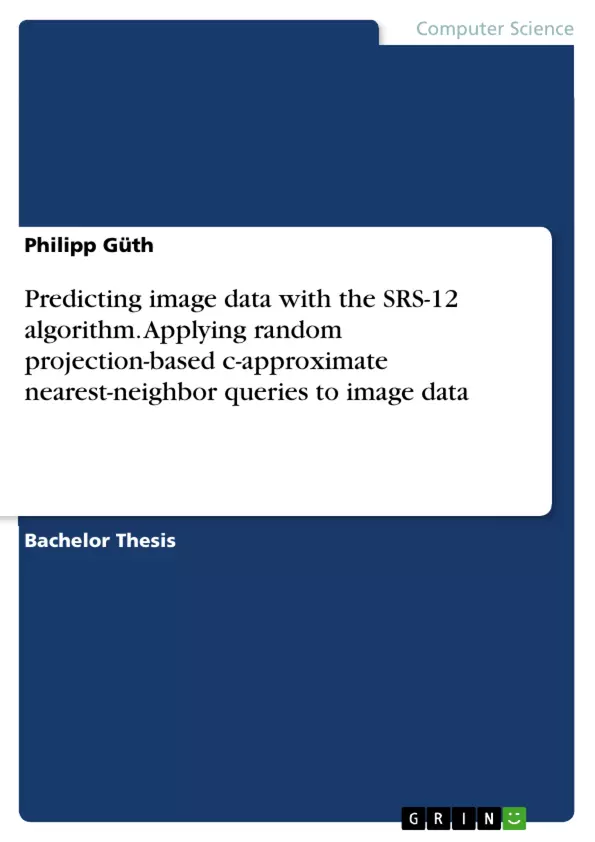
Predicting image data with the SRS-12 algorithm. Applying random projection-based c-approximate nearest-neighbor queries to image data
Bachelorarbeit, 2015
41 Seiten, Note: 1.0
Leseprobe
Inhaltsverzeichnis (Table of Contents)
- Introduction
- Motivation
- Problem Statement
- Objectives
- Structure of this Thesis
- A brief history and overview of Approximate Nearest-Neighbor Queries
- Improving Index Structures
- Softening Requirements for Accuracy
- Further Related Work
- An Introduction to SRS-12
- Why SRS-12 is worth a consideration
- SRS-12 in a Nutshell
- Variants of SRS-12
- Indexing
- Normal Stopping Condition of the SRS-12 Algorithm
- Implementation & Experimental Evaluation
- Implementation Details for the Computation of Parameter Values
- Datasets
- Verification on SIFT1M Dataset
- Block Matching
- A Brief Introduction to Block Matching
- Methodology
- Parameter Settings
- Computation Time
- Conclusions
- Summary - Recommended Parameter Settings
- Computation Time of SRS-12 vs Exact Nearest-Neighbor Search
- Possible Optimizations
- Future Work
- Image Prediction
- Reducing Data through Rapid Object Detection and Background Removal
- Optical Flow
- Increasing the Accuracy of the SRS-12 Algorithm
- Discussion
Zielsetzung und Themenschwerpunkte (Objectives and Key Themes)
This thesis aims to evaluate the performance of the SRS-12 algorithm on real-world image data, laying the groundwork for future research on image prediction. The SRS-12 algorithm is a method for finding approximate nearest neighbors that promises a small index and arbitrary approximation ratios while maintaining good theoretical guarantees.
- The efficiency and effectiveness of the SRS-12 algorithm for image data processing.
- The impact of different parameter settings on the quality and computation time of the algorithm.
- The suitability of SRS-12 for real-time applications.
- Potential optimizations and applications of the algorithm in the field of image prediction.
- The comparison of SRS-12 to traditional nearest-neighbor search methods.
Zusammenfassung der Kapitel (Chapter Summaries)
The introduction presents the motivation behind the thesis, outlining the importance of finding similar points in various scientific and economic applications, particularly in the context of big data. It highlights the challenges associated with traditional nearest-neighbor search methods, especially in high-dimensional spaces. The chapter then introduces the SRS-12 algorithm and its potential benefits in addressing these challenges.
Chapter 2 provides a brief overview of approximate nearest-neighbor queries, exploring different approaches and advancements in index structures, accuracy requirements, and related work. Chapter 3 delves into the SRS-12 algorithm, explaining its core principles, variants, indexing techniques, and stopping conditions.
Chapter 4 focuses on the implementation and experimental evaluation of the SRS-12 algorithm. It details the implementation process, the datasets used, and the verification of the algorithm on the SIFT1M dataset. The chapter further explores the application of SRS-12 in block matching, analyzing the impact of parameter settings, computation time, and overall performance. It concludes by providing recommendations for optimal parameter settings.
Chapter 5 outlines potential future research directions, including the application of SRS-12 to image prediction, data reduction through object detection and background removal, optical flow analysis, and further optimizations to enhance the accuracy of the algorithm.
Schlüsselwörter (Keywords)
This thesis focuses on the SRS-12 algorithm, approximate nearest-neighbor queries, image data processing, block matching, parameter optimization, real-time applications, image prediction, and high-dimensional Euclidean space.
Details
- Titel
- Predicting image data with the SRS-12 algorithm. Applying random projection-based c-approximate nearest-neighbor queries to image data
- Hochschule
- Ruprecht-Karls-Universität Heidelberg (Computer Science)
- Note
- 1.0
- Autor
- Philipp Güth (Autor:in)
- Erscheinungsjahr
- 2015
- Seiten
- 41
- Katalognummer
- V305214
- ISBN (eBook)
- 9783668033542
- ISBN (Buch)
- 9783668033559
- Dateigröße
- 2343 KB
- Sprache
- Englisch
- Schlagworte
- Machine Learning Big Data Image Prediction Predictive Analytics Nearest Neighbors Image Recognition SRS-12
- Produktsicherheit
- GRIN Publishing GmbH
- Preis (Ebook)
- US$ 20,99
- Preis (Book)
- US$ 29,99
- Arbeit zitieren
- Philipp Güth (Autor:in), 2015, Predicting image data with the SRS-12 algorithm. Applying random projection-based c-approximate nearest-neighbor queries to image data, München, Page::Imprint:: GRINVerlagOHG, https://www.diplomarbeiten24.de/document/305214
- Autor werden
- Ihre Optionen
- Vertriebskanäle
- Premium Services
- Autorenprofil
- Textarten und Formate
- Services für Verlage, Hochschulen, Unternehmen

- © GRIN Publishing GmbH.
- Alle Inhalte urheberrechtlich geschützt. Kopieren und verbreiten untersagt.
- info@grin.com
- AGB
- Open Publishing
Der GRIN Verlag hat sich seit 1998 auf die Veröffentlichung akademischer eBooks und Bücher spezialisiert. Der GRIN Verlag steht damit als erstes Unternehmen für User Generated Quality Content. Die Verlagsseiten GRIN.com, Hausarbeiten.de und Diplomarbeiten24 bieten für Hochschullehrer, Absolventen und Studenten die ideale Plattform, wissenschaftliche Texte wie Hausarbeiten, Referate, Bachelorarbeiten, Masterarbeiten, Diplomarbeiten, Dissertationen und wissenschaftliche Aufsätze einem breiten Publikum zu präsentieren.
Kostenfreie Veröffentlichung: Hausarbeit, Bachelorarbeit, Diplomarbeit, Dissertation, Masterarbeit, Interpretation oder Referat jetzt veröffentlichen!
- GRIN Verlag GmbH
-
- Nymphenburger Str. 86
- 80636
- Munich, Deutschland
- +49 89-550559-0
- +49 89-550559-10
- info@grin.com
-









